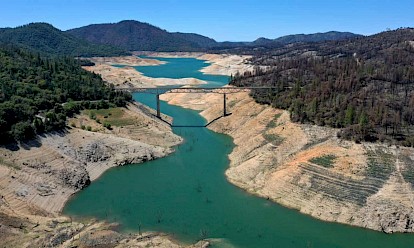The Hoover Dam made life in the West possible. Or so we thought
 Few things force you to confront hubris and genius at the same time as much as the magnificent harness on the Colorado River that created the largest reservoir in the United States.
Few things force you to confront hubris and genius at the same time as much as the magnificent harness on the Colorado River that created the largest reservoir in the United States.
To build Hoover Dam in the 1930s, an army of Depression-era daredevils poured enough concrete to form a two-lane road from Seattle to Miami. The dam powered Los Angeles and birthed modern Las Vegas. Downriver canals made Arizona habitable year-round, delivered cold water to drinking fountains in Disneyland and created an Eden for winter vegetables in Southern California.
Humans bent nature to their will to shape a civilization in an arid land. Now, human activity — the accelerant of climate change — is threatening those dreams. Lake Mead, the big man-made body of water behind the dam, has sunk to near its lowest level since it was filled, signaling ripples of change in the world made possible by the backed-up Colorado River.
You may think you’ve seen this movie before: the parched and elaborately plumbed West crying for relief. But the dry spell that began at the dawn of this century, and has persisted for nearly two decades, is one for the ages. Scientists call this a megadrought, one of the worst in nearly 500 years. And this is just the beginning.
Still, why care about the big bathtub in the backyard of Las Vegas, that improbable, well-watered city in the middle of the Mojave Desert? It’s easy to make fun of a place where ads for divorce lawyers pop up a screen while you pump your gas, where one planned community is called the Lakes and another Desert Shores.
Las Vegas is among the fastest-warming cities in the United States, its average temperature having risen more than four degrees since 1970, according to one analysis. But Vegas, and other oasis metropolises like Los Angeles, Phoenix and Tucson, are not the problem. Water use has actually fallen in Arizona since the 1950s. These cities have been praised for creative use of the world’s most precious resource by conservationists.
The problem is us — a planet in fast-declining health. Think of Lake Mead as the world’s largest heart monitor. Right now, it’s showing extreme distress. Within a few months, water levels are projected to reach a critically low threshold that will force cutbacks throughout the system.
Nobody wants a desiccated West, a place where dying trees outnumber the living ones in many places, where wildfires are not a seasonal siege but a year-round peril, where once-fertile fields are permanently fallowed.
But it’s here now, and a reservoir built to hold enough water to flood all of New York State a foot deep appears to be inexorably drying up.
The other day I walked the floor of Lake Mead, a cracked and sun-baked Martian-scape that was once more than a hundred feet underwater. On the horizon, the eerie geologic formations that freaked out early white explorers displayed the latest bathtub rings in the rock.
Beyond the Southwest, the message of a vast and fast-evaporating artificial lake is that we can’t engineer our way out of this problem. The region is a relic of an era of ingenuity, and promise. Hoover Dam, like its upstream companion that created Lake Powell, demonstrated American engineering muscle at the peak of its powers. The dams were built around the idea that we’re bigger than any obstacle of nature; we can dynamite, dig and fill our way into creating a hydraulic machine.
And for more than 80 years, things have mostly worked as intended. As it flows for 1,450 miles from snowmelt in the high Rockies to a trickle in the Gulf of California, the Colorado River serves 40 million people. It meanders by fields, forests and cliffs in the upper basin and powers through Grand Canyon and other national parks in its lower half. But over the last century, natural flows have decreased by about 20 percent, largely because of climate change.
So long as the world continues to warm, no amount of new dams can resuscitate a gasping resource. Doing all the right things — growing more food and building smarter communities with less water — can only go so far.
A previous megadrought in these parts may have compelled the Ancestral Pueblo cultures, also known as the Anasazi, to abandon their homes in the cliffs during the 1200s. That’s one theory, for they didn’t leave behind a detailed history. Only the empty dwellings.
Scientists know about their catastrophe from studying tree rings, a book of nature with chapters on wet and dry years. Of course, this was well before we started pumping greenhouse gases into the atmosphere. Their peril was believed to have come from years of drought, not a warming earth. In the modern age, dry years can be somewhat managed. Climate cannot.
An ancient tree would suggest that we can live through this, as well. But what if the tree can’t make it through this year, or next? Then, we’ll be left with human artifacts, the shell of Las Vegas, a lake no more, to tell the story of what happened. The cause will not be a mystery.
You can return to the main Market News page, or press the Back button on your browser.

